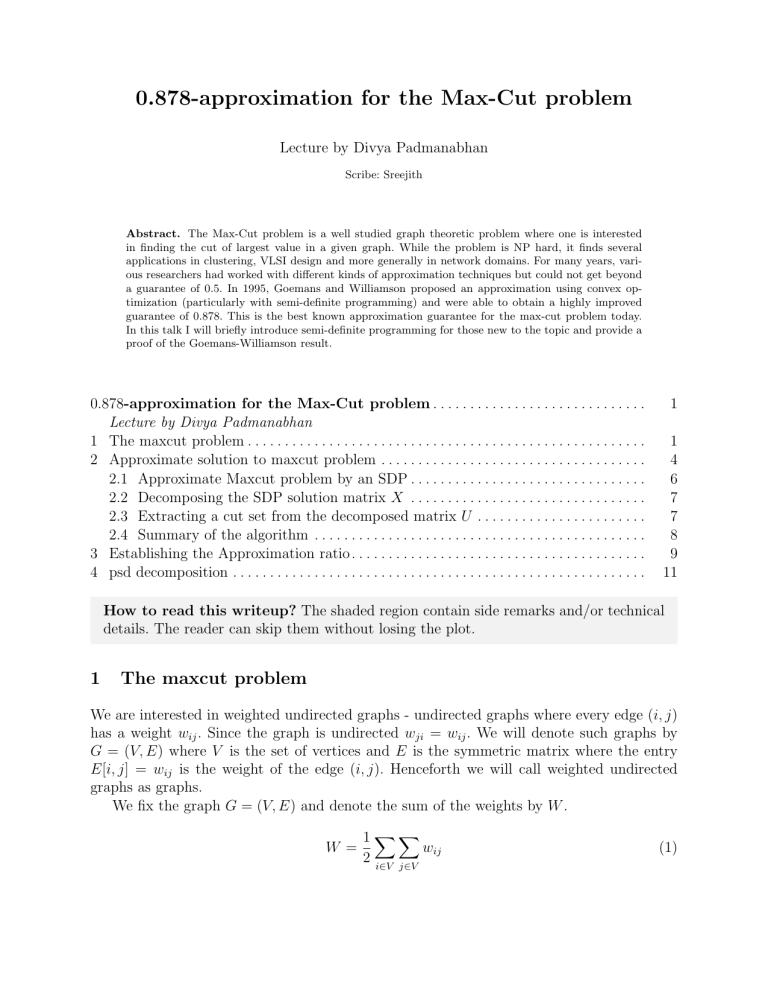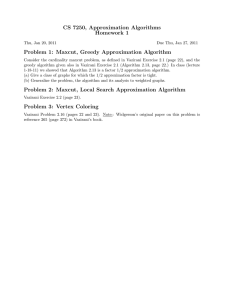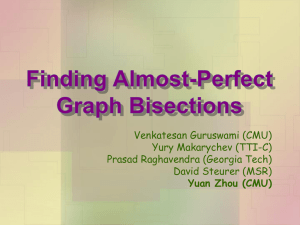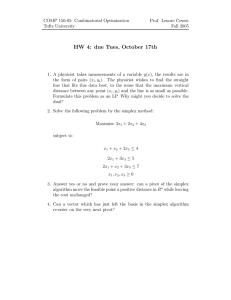
0.878-approximation for the Max-Cut problem
Lecture by Divya Padmanabhan
Scribe: Sreejith
Abstract. The Max-Cut problem is a well studied graph theoretic problem where one is interested
in finding the cut of largest value in a given graph. While the problem is NP hard, it finds several
applications in clustering, VLSI design and more generally in network domains. For many years, various researchers had worked with different kinds of approximation techniques but could not get beyond
a guarantee of 0.5. In 1995, Goemans and Williamson proposed an approximation using convex optimization (particularly with semi-definite programming) and were able to obtain a highly improved
guarantee of 0.878. This is the best known approximation guarantee for the max-cut problem today.
In this talk I will briefly introduce semi-definite programming for those new to the topic and provide a
proof of the Goemans-Williamson result.
0.878-approximation for the Max-Cut problem . . . . . . . . . . . . . . . . . . . . . . . . . . . . .
Lecture by Divya Padmanabhan
1 The maxcut problem . . . . . . . . . . . . . . . . . . . . . . . . . . . . . . . . . . . . . . . . . . . . . . . . . . . . . .
2 Approximate solution to maxcut problem . . . . . . . . . . . . . . . . . . . . . . . . . . . . . . . . . . . .
2.1 Approximate Maxcut problem by an SDP . . . . . . . . . . . . . . . . . . . . . . . . . . . . . . . .
2.2 Decomposing the SDP solution matrix X . . . . . . . . . . . . . . . . . . . . . . . . . . . . . . . .
2.3 Extracting a cut set from the decomposed matrix U . . . . . . . . . . . . . . . . . . . . . . .
2.4 Summary of the algorithm . . . . . . . . . . . . . . . . . . . . . . . . . . . . . . . . . . . . . . . . . . . . .
3 Establishing the Approximation ratio . . . . . . . . . . . . . . . . . . . . . . . . . . . . . . . . . . . . . . . .
4 psd decomposition . . . . . . . . . . . . . . . . . . . . . . . . . . . . . . . . . . . . . . . . . . . . . . . . . . . . . . . .
1
1
4
6
7
7
8
9
11
How to read this writeup? The shaded region contain side remarks and/or technical
details. The reader can skip them without losing the plot.
1
The maxcut problem
We are interested in weighted undirected graphs - undirected graphs where every edge (i, j)
has a weight wij . Since the graph is undirected wji = wij . We will denote such graphs by
G = (V, E) where V is the set of vertices and E is the symmetric matrix where the entry
E[i, j] = wij is the weight of the edge (i, j). Henceforth we will call weighted undirected
graphs as graphs.
We fix the graph G = (V, E) and denote the sum of the weights by W .
W =
1 XX
wij
2 i∈V j∈V
(1)
A cut in a graph is a set S ⊆ V . We also denote the complement of S by T = V \S.
Note that a cut partitions the sets of vertices into two parts S and T . The set of edges, on
the other hand, are partitioned into three parts. One part contains all the edges in S, and
another part has all the edges in T . We are interested in the third type of edges - those split
by the cut. One vertex of such an edge is in S, and another vertex is in T . There is a natural
way to assign a weight to a cut S - the sum of weights of the split edges.
X
W(S) ::=
wi,j
(2)
(i,j)∈S×T
We are interested in finding the cut with the maximum weight.
The maxcut problem: Given a graph, find a cut of maximum weight.
Note that there might be multiple cuts with the same maximum
weight. Finding one such cut is sufficient. Let us look at an example.
Example 1. Some of the cuts and associated weights of Fig. 1 are
1.
2.
3.
4.
For
For
For
For
S
S
S
S
= {1, 2, 3}, W(S) = 8.
= {1, 2, 3, 4}, W(S) = 4.
= ∅, W(S) = 0.
= {1, 3, 5}, W(S) = 15.
Fig. 1. A weighted graph
The maxcut is the cut S = {1, 3, 5}.
We make the following assumption regarding the input graphs.
Assumption: The weights wij are non-negative integers.
This is not a severe restriction since any graph with negative or rational weights can be
reduced to a graph with non-negative integer weights.
Removing the assumption: To remove negative entries, add all the weights with
the maximum absolute value of the weights. To remove fractional weights multiply all
the weights with the lcm of the denominators. Neither of these reductions changes the
maximum cut set. Moreover, the input size stays polynomial. The lcm of n numbers ≤ k
is bound by k n and takes O(n log k) space. This is polynomial in the input size.
Computational complexity of maxcut: The decision version (a Yes/No problem) of
the maxcut optimization problem is
maxcut decision version: Given a graph and a number k, does there exists a
cut of weight at least k?
The above problem is NP-complete. It is easy to see that the problem is in NP- guess
the cut S and verify its weight is at least k. We skip the proof of hardness.
It is also easy to see that if we can solve the optimization problem in polynomial time,
then the decision version is in P. What about the other direction: Can we solve the
2
optimization problem in polynomial time if the decision version is in P? Here is a first
attempt. Run the decision version for the weight k ranging from 0 to W (sum of all
weights). The largest k for which the algorithm returns Yes is the weight of the maxcut.
To find the maxcut from this k, we can do the following. Pick an edge (i, j) and force
this edge to be in the maxcut by giving it a weight of W + wij . If this edge was in the
original maxcut the decision version should return Yes for the new graph and weight
W + k; otherwise, it should return No. Once the decision on edge (i, j) is made, pick
another edge and repeat the procedure (with a slight change). If the previous edge was
in the maxcut, update the weight of that edge to W + wij and continue; if the edge was
not in maxcut we go back to our original graph. This procedure is repeated at most m
times where m is the number of edges. The total running time is, therefore, a polynomial
times W . Unfortunately, this is pseudo-polynomial time since W is “exponential in the
input size” because the input weights are in binary notation. We need to reduce the
running time to log W . In the second attempt, we do a binary search from 0 to W . We
run the decision version with k = W2 and based on whether the answer is Yes or No, we
search the range [0, W/2] or [W/2, W ].
In short, the optimization and decision versions are “similar” in their running time.
Given that the decision problem is NP-hard, there is little hope of a polynomial-time
algorithm for the optimization version.
It is known that unless P=NP, maxcut cannot be solved in polynomial time. In many
practical applications, an “approximation” to the best solution is better than no solution.
Does there exist a polynomial-time algorithm that can approximate the maxcut? Before we
answer that, we need to define the meaning of an approximate solution. For an input graph
G, we denote by OPT(G) the weight associated with the maxcut. That is,
OPT(G) ::= max{W(S) | S is a subset of vertices in G}
An approximation algorithm aims to find a cut whose weight is very near OPT(G). Let us
assume you have written such an approximation algorithm A. Clearly,
A(G) ≤ OPT(G)
We say that algorithm A is an α-approximation for an α ∈ (0, 1] if
α OPT(G) ≤ A(G),
(for all input instance G)
The larger the α, the better the approximation algorithm. We aim to show that maxcut has
a 0.878-approximation. That is, we give an algorithm A such that
0.878 OPT(G) ≤ A(G) ≤ OPT(G),
3
(for all input instance G)
Can we do better than this? What about a 0.999-approximation? This is unfortunately
not possible. The result follows from a deep result known as the PCP-theorem (see
Arora and Barat complexity theory book [1]). The theorem shows that unless NP=P,
optimization problems like the maxcut problem do not have an -approximation for all
≈ 0.941 and shows that any algorithm
< 1. Hastad in [3] gives an explicit = 16
17
bettering this -approximation is not possible. Khot et al. [4] showed that this 0.878approximation is the best possible algorithm if the unique games conjecture is true.
Are there optimization problems that can be approximated to any as we want? Yes.
The Knapsack problem can be approximated to any as one wishes. Such problems are
said to admit a PTAS.
2
Approximate solution to maxcut problem
Goemans and Williamson [2] gave the 0.878-approximation algorithm. In this talk, we only
look at a randomized algorithm whose expected optimal value is at least 0.878 OPT. A
randomized algorithm takes as input a graph and a sequence of random bits. Let A be a
randomized approximation algorithm for maxcut. We are interested in showing the following.
0.878 OPT(G) ≤ E(A(G)) ≤ OPT(G),
(for all input instance G)
where E(A(G)) is the expectation taken over all the random choices of A. Let us first recast
the maxcut problem.
1 XX
max
wij (1 − xi xj )
(P1)
4 i∈V j∈V
subject to the constraints, xi ∈ {−1, +1}
The problem is highly non-convex (infact, an integer programming problem). For what assignment to xi s do we get the maximum for the objective function? Let S be the maxcut
solution. Assign xi = 1 if i ∈ S. Otherwise assign xi = −1. Therefore (1 − xi xj ) = 0 if xi and
xj are both in S or both not in S. Otherwise, (1 − xi xj ) = 2. The weights in the cut S are
added twice, whereas the weights outside the cut are not added. Thus, a maxcut solution
produces the optimum solution to the above problem. How about the other direction? Does
an optimal solution to the above problem give rise to a maxcut solution? We leave this as
an exercise.
We rewrite P1 into an equivalent version.
1 XX
wij (1 − Xij )
(P2)
max
4 i∈V j∈V
subject to the constraints, X = xxT , and Xii = 1
(for all i ∈ V )
Here xT is the transpose of the vector x and X is a matrix. Note that the entry at Xij = xi xj
for all i, j ∈ V . The condition Xii = 1 is equivalent to x2i = 1 which is equivalent to
xi ∈ {−1, +1}. We claim P2 is same as P1. The proof is left as an exercise for the reader.
4
We now show how to approximate P2. The main idea is as follows. The optimization
problem P2 associates a variable xi ∈ {−1, +1} with a vertex i. We can view the vertices
as being assigned a unit vector in R1 (one dimension). The vectors assigned to the vertices
on the opposite sides of the cut point in opposite directions, and the vectors assigned to
the vertices on the same side of the cut point in the same direction. The SDP (semidefinite
program) relaxation allows the vertices to be assigned a unit vector in Rn (n dimension).
We keep our objectives the same as before. Those on the opposite sides of the cut should be
pointing in approximately opposite directions. In contrast, those on the same side of the cut
should be pointing in approximately the same direction. Fig. 2 gives a pictorial view of this
relaxation. We then extract the cut from a solution to this SDP relaxation.
Fig. 2. SDP relaxation: The vertices are mapped to unit vectors in R1 in the optimization problem P2. In the
approximation version, the vertices are mapped to unit vectors in Rn .
The three main steps in this approximation algorithm are
1. Approximate P2 by a SDP optimization problem P3.
2. Decompose the solution to the optimization problem P3.
3. Extract a cut set from this decomposition.
We now provide details of each of these. This is followed by showing that this approximation
algorithm runs in polynomial time. The argument that this is indeed a 0.878-approximation
is deferred to the next section.
5
2.1
Approximate Maxcut problem by an SDP
An SDP (semi-definite program) is a special case of a convex optimization problem. The
SDP that approximates maxcut is given below.
max
1 XX
wij (1 − Xij )
4 i∈V j∈V
(P3)
subject to the constraints,
1 x11 · · · x1n−1 x1n
x11 1 · · · · · · x2n
is a psd
··· ··· ···
X=
x1n−1 · · · · · · 1 xn−1n
x1n x2n · · · xn−1n 1
The matrix X is a symmetric positive semi-definite matrix (psd). Such matrices satisfy the
condition that X = RRT for an n × k real matrix R and some k > 0. Note that X in problem
P2 is also a symmetric psd (it is of the form xxT ). How is P3 different from P2?
1. X in P2 was a rank-1 matrix whereas X in P3 has no rank restriction.
2. The information contained in individual variables xi s (or vertices) are lost in P3. The
“hope” is to retrieve the individual vertex information from the matrix X.
3. The xi s in P2 can only take +1 or −1 values and hence the matrix X contain only +1
or −1 entries. In problem P3 there is no such restriction on the matrix X.
As mentioned above, we have lost some information by this relaxation on the matrix X.
What have we gained? There is a polynomial-time algorithm to solve an SDP. In contrast,
the problem P2 cannot be answered in polynomial time (unless P=NP).
Theorem 1. There is an algorithm (we call it SolveSDP) that takes as input an SDP P3
and in polynomial time returns the optimal solution matrix X.
A caveat: There is a small catch when we say SDP can be solved in polynomial time. The
optimal solution X might contain irrational numbers. From an algorithmic point of view,
we cannot store or do real number computations. One can work with “rational numbers”
close to real numbers. We say that matrices X and Y are δ close if |Xij − Yij | ≤ δ. In
other words, all the entries are within δ distance.
Theorem 1. There is an algorithm, which when given SDP P3 and a δ > 0, returns a
matrix X in time polynomial in the input SDP and log 1/δ such that X is δ close to the
optimal solution. Moreover, X is a symmetric psd.
Note that the algorithm can get very close to the optimal value. How close is based
on the input parameter δ. The smaller the δ, the more the running time of SDP.
6
2.2
Decomposing the SDP solution matrix X
Our aim is to now extract the cut set from the solution matrix X of P3. In Problem P2, X
is of the form xxT . The binary value of xi decides whether the vertex i is in the maxcut or
not. Unfortunately, the matrix X of P3 need not be of this form.
Let us consider the solution matrix X of P3. Since X is symmetric and psd, there exists
an n × k real matrix U such that X = U U T . There are two ways to decompose the matrix
X: (1) using eigen decomposition and (2) using Cholesky decomposition.
Lemma 1 (decomposition). There is an O(n3 ) algorithm which on input a symmetric
psd X returns a matrix U such that X = U U T .
A proof of the lemma using Cholesky decomposition is given in Section 4. The running time
of an eigen decomposition depends on the ratio of the eigen values. The best case being
better and the worst case being worse than the Cholesky decomposition.
A caveat: Again, there is a problem when the decomposition matrix U is irrational. This
is highly likely since U is like a “square root” matrix. This necessitates an approximate
decomposition of a symmetric psd.
Lemma 1 (decomposition). There is a real matrix U such that X = U U T . Moreover,
there is an algorithm, which given X and a δ > 0, returns U in time polynomial in input
size of X and log 1/δ such that
bij − δ ≤ Xij ≤ X
bij + δ
X
b = U U T . In short, X
b is δ close to X.
where X
b are close to 1. Therefore
Since Xii = 1 for all i, the diagonal elements of X
1 − δ ≤ ui T ui ≤ 1 + δ
2.3
(for all row vectors ui of U )
Extracting a cut set from the decomposed matrix U
The row vectors of U (denoted as ui s) contain information for each vertex in the graph.
Recap how xi s in Problem P2 (the original maxcut problem) determined whether i is in the
maxcut or not. In that setting, vertices i and j fall in the same set (either S or T ) if xi xj = 1.
Let us return to the problem P3 and the vectors ui and uj . We have that Xij = ui T uj . When
Xij is high (close to 1), we would want i and j to be in the same set. Since the inner product
is proportional to the angle between the vectors, it follows that we want i and j to be in the
same set if the angle between ui and uj is small. There is a problem, however. Consider the
following scenario: the angle between vectors ui and uj is small. Between uj and uk is small.
However, the angle between ui and uk is not small. We are in a predicament whether to
include all the three vectors i, j and k in the same set or not. The angle between the vectors
7
is not an “equivalence” relation. Therefore, we are interested in a “clustering” algorithm partition the vectors ui s into two parts such that angles inside a part are minimized.
Randomization allows clustering the vectors into two parts. We pick a random vector
r, and all vectors close to it (less than 90 degree) are included in S, whereas all the other
vectors are included in T . Algorithm 1 contains the details. It is easy to observe that the
algorithm runs in randomized polynomial time.
Algorithm 1 Cluster the vectors into two parts
Initialize set S = ∅.
Pick a random vector r ∈ R|V | such that |r|2 = 1.
for i ∈ V do
if rT ui ≥ 0 then
add i to S
end if
– i is not added to S if rT ui < 0
end for
return S
In the above algorithm, the only non-trivial part is picking a random vector r in the unit
sphere’s surface. We can do this by picking ri randomly from the normal distribution
N (0, 1). With a high probability, r is in the unit sphere’s surface; the probability increases
with the dimension. There are some implementation issues. Theoretically, we pick real
numbers from the normal distribution. But practically, we leave out all the real numbers.
Moreover, the rational numbers we pick can only be of the form pq where p and q are
polynomial in the size of the input. Thus, an “algorithm” assigns all “un-representable”
numbers to probability 0. Does picking from the rest of the numbers (based on normal
distribution probability) also give a vector on the unit sphere’s surface?
We need to discuss a special case. Note that if ui = uj then the vertices behave similarly.
The vertex i is put in the same set as vertex j. Therefore, we remove vertex i and vector ui
from the algorithm analysis. The following assumption is important.
Assume: for all i 6= j, ui 6= uj and Xij 6= 1
(3)
This concludes the randomized algorithm.
2.4
Summary of the algorithm
The algorithm consists of mainly three steps, each running in polynomial time. (1) Approximation using SDP, (2) Decomposition of the solution to the SDP (3) Clustering the vectors
from the decomposition. The following section shows that this algorithm gives in expectation
a maxcut which is 0.878-approximate. See the complete algorithm in Algorithm 2.
8
Algorithm 2 ApproximateM axCut
1:
2:
3:
4:
5:
6:
7:
8:
9:
10:
11:
12:
13:
14:
15:
16:
17:
18:
– Input: A weighted graph G = (V, E)
– Output: A 0.878-approximation to maxcut
SDP P = Approximate the maxcut problem into the form P3
– Solve the SDP P
X = SolveSDP(P )
– Decompose X into U U T
U = Decomposition(X)
Let {u1 , . . . , u|V | } be the rows of U .
Let S = ∅. – Set S will be the cut.
Pick a random vector r ∈ R|V | such that |r|2 = 1.
for i ∈ V do
if rT ui ≥ 0 then
– angle between r and ui is less than 90 degree
add i to S
end if
– i is not added to S if rT ui < 0
end for
return S
Some questions:
1. Rather than pick a random vector r, why not pick one of the vectors ui randomly,
and add all uj s close (angular-wise) to it into S.
2. Is there any relation between the rank of returned X and the closeness of approximation?
3. Why not find the best 1-rank approximation to the SDP return matrix X and use
that as an indicator for recognizing the cut.
3
Establishing the Approximation ratio
Let us call ApproximateMaxCut (Algorithm 2) as A. Assume that A returns S on input G.
For ease of analysis, we assume Algorithms SolveSDP and Decomposition gives the
optimal matrix X and the exact decomposition matrix U and not a δ approximation.
Our aim is to show that
0.878 OPT(G) ≤ E(W(S))
where the expectation is computed over the random choices of r. Consider the indicator
random variables Yij
(
0, if i and j are either both in S or both in T
Yij =
1, otherwise
9
The expected weight of the cut returned by A is
1 XX
E(W(S)) = E(
wij Yij )
2 i∈V j∈V
1 XX
wij E(Yij )
(by linearity of expectation)
=
2 i∈V j∈V
1 XX
E(Yij ) =
wij (1 − Xij )
(from Eq. (3), Xij 6= 1)
2 i∈V j∈V
1 − Xij
1 XX
2 E(Yij ) =
wij (1 − Xij )
4 i∈V j∈V
1 − Xij
n 2 E(Y ) o 1 X X
ij
≥ min
wij (1 − Xij )
i,j∈V
1 − Xij 4 i∈V j∈V
n 2 Prob(Y = 1) o 1 X X
ij
= min
wij (1 − Xij )
i,j∈V
1 − Xij
4 i∈V j∈V
(Since Yij is an indicator random variable)
n 2 Prob(Y = 1) o
ij
OPT(G)
≥ min
i,j∈V
1 − Xij
The last equality follows from the fact that X is an optimal solution to P3 and OPT(G) is
achieved by an 1-rank matrix X̂ which is a feasible solution for the SDP P3. To show our
approximation ratio, it is sufficient to bound
n 2 Prob(Y = 1) o
ij
min
> 0.878
i,j∈V
1 − Xij
First, we find the probability that i and j are on the opposite sides of the cut. By our
algorithm, this happens if and only if the angle between r and ui is acute and the angle
between r and uj is obtuse or vice versa.
Prob(Yij = 1) = 2 Prob(rT ui ≥ 0 and rT uj < 0)
Let θ be the angle between vectors ui and uj . We show the following
Prob(rT ui ≥ 0 and rT uj < 0) =
θ
2π
This is rotational symmetric - the probability remains the same if we rotate all the vectors
by the same angle.
Prob(rT ui ≥ 0 and rT uj < 0) = Prob((Qr)T Qui ≥ 0 and (Qr)T Quj < 0)
where Q is any orthonormal matrix - columns are perpendicular to each other and also
have unit norm. Therefore QT Q is the identity matrix. Rotational matrices are orthonormal
10
matrices. Let Q be a matrix which rotates ui to the x-axis (giving ûi ) and uj to the xy plane (giving ûj ) . In other words except for the first co-ordinate in ûi and the first
two co-ordinates in ûj all other co-ordinates are zero. That is, ûi = (u1i , 0, 0, . . . , 0) and
ûj = (u1j , u2j , 0, 0, . . . , 0). Let r̂ be the projection of r on the x-y plane. Since apart from
the first two co-ordinates all the other co-ordinates of ûi and ûj are zeros, rT ûi = r̂T ûi and
rT ûj = r̂T ûj . So, it is sufficient to analyse the probability in the 2 dimensional x-y plane.
θ
Figure 3 provides a “visual” proof of Prob(rT ui ≥ 0 and rT uj < 0) = 2π
. Hence
θ
Prob(Yij = 1) = π . Therefore
2 Prob(Yij = 1)
2θ
2θ
=
=
1 − Xij
π(1 − Xij )
π(1 − cos θ)
The last equality comes from the fact that Xij = ui T uj = cos θ, and because for all l ∈ V ,
ul T ul = 1. The paper [2] claims that basic calculus shows
o
2θ
> 0.878
min
θ
π(1 − cos θ)
n
This concludes the analysis of the algorithm.
A
D
uj
θ
ui
B
1.
2.
3.
4.
Region
Region
Region
Region
A: rT ui ≥ 0 and rT uj
B: rT ui ≥ 0 and rT uj
C: rT ui < 0 and rT uj
D: rT ui < 0 and rT uj
<0
≥0
≥0
<0
C
Fig. 3. A random vector r can lie in any of the four regions. Region A (resp. C) cover
that i ∈ S and j ∈
/ S is equal to the area of region A.
θ
2π
of the area. The probability
If the matrices have irrational entries, we work with matrices δ close to the optimal.
Maintaining an 0.878-approximation is possible since we can take a δ as close to the
optimal as we want.
4
psd decomposition
This section shows that a symmetric positive semidefinite matrix X can be decomposed as
a product of a matrix and its transpose.
11
We say a matrix is lower triangular (resp. upper triangular) if all entries above (resp.
below) the diagonal are zero and the diagonal entries are 1.
Claim. Let X be any full rank matrix. Then X = LDU for a lower triangular matrix L,
diagonal matrix D and upper triangular matrix U .
Moreover if X is rational L, D and U are rational and an algorithm can output L, D and
U in O(n3 ).
Proof (Proof sketch (see Strang [5]).). Consider the full rank matrix X. We can do a
row operation and make the first column second row cell to zero. Let this new matrix
be Y . You can also go back from Y to X be doing the reverse row operation. Both these
row operations (are linear transformations) are equivalent to multiplication by a lower
triangular matrix. That is
X = L̂Y
(where L̂ is lower triangular)
By a series of such operations (gaussian elimination) you can get a matrix Û where all
entries below the diagonal are zero (the diagonal entries need not be 1). These series
of row operations are equivalent to multiplication by lower triangular matrices. Since
product of lower triangular matrices are lower triangular we have
X = L̂1 L̂2 . . . L̂n Û = LÛ
(here L is lower triangular)
We can factor out the diagonal elements in Û as follows
d1
1 a12 /d1 a13 /d1
d2
1 a23 /d2
Û =
·
·
dn
1
=DU
(here D is diagonal and U is upper triangular)
Therefore X = LDU . By a careful analysis one can establish that this decomposition
can be done in O(n3 ).
t
u
Claim. Let X be a full rank symmetric matrix. Then X = LDLT for a diagonal matrix
D and lower triangular matrix L. Moreover, if X is rational L and D are rational.
Proof. Since X = LDU by the above theorem and X = X T we have X = LDU =
U T DLT . Take L to the other side (this is possible since X is full rank). That is DU (LT )−1 =
L−1 U T D. Since one is a left triangular matrix and the other right triangular, the only
possibility is it is a diagonal matrix. By looking at the diagonals it follows that L = U T .
t
u
We now show that symmetric psd matrices X have a factorization V V T . We make use of the
following property of psd matrices.
12
Lemma 2. X is a psd iff the pivots of X are greater than or equal to 0.
Lemma 3 (Choleksy decomposition)). Let δ > 0. There is an algorithm that returns a
matrix V on input a symmetric psd X in time polynomial in X and log 1/δ and such that
X is δ close to V V T .
Proof. We first show the decomposition for symmetric positive definite matrices (these are
full rank matrices). Assume Y is a full rank symmetric psd. Since X is symmetric and full
rank we have that Y = LDLT from Section 4. From the previous claim, the pivots are
non-negative. Therefore, there are real square roots for the diagonal entries of D.
√
√ T
√ √
Y = LDLT = L D DLT = L D(L D) = V V T
Let us now extend the above argument for symmetric positive semidefinite matrices. These
matrices need not be of full rank. Consider such an X
Y
X=
A
AT
N
where Y is a full rank submatrix and the rows of [A N ] are dependent on the rows of [Y AT ].
Therefore, there is a matrix Z such that Z[Y AT ] = [A N ]. In other words
ZY = A, ZAT = N and therefore Z = AY −1 and AY −1 AT = N
(4)
Since Y is a symmetric positive definite matrix there exists a V such that V V T = Y . We
can therefore write X as
Y AT V
=
X=
A N M
VT
MT
(5)
where M is such that V M T = AT or M T = V −1 AT (this is possible since Y is full rank and
therefore V is also full rank). We need to verify that M M T = N .
T
M M T = A(V −1 ) V −1 AT = AY −1 AT = N
Where the last equality follows from Eq. (4). From Eq. (5) it follows that X = V̂ V̂ T for
a matrix V̂ . This concludes the proof of the fact that a psd can be decomposed into the
product of a matrix and its transpose.
13
Finally, we have to argue the algorithmic complexity. We only used gaussian elimination
and inverses of matrices. A detailed analysis will show an O(n3 ) running time. Moreover, the
only place where an approximation is required is while finding the square root of the diagonal
entries of matrix D. Newton’s method can approximate this to an accuracy as claimed in
the statement of the theorem.
t
u
References
1. Sanjeev Arora and Boaz Barak. Computational Complexity: A Modern Approach. Cambridge University Press,
2009.
2. Michel X. Goemans and David P. Williamson. Improved approximation algorithms for maximum cut and satisfiability problems using semidefinite programming. Journal of the ACM, 42(6):1115–1145, 1995.
3. J. Hȧstad. Some optimal inapproximability results. Journal of the ACM, 48(4):798–859, 2001.
4. Subhash Khot, Guy Kindler, Elchanan Mossel, and Ryan O’Donnell. Optimal inapproximability results for maxcut and other 2-variable csps? SIAM J. Comput., 37(1):319–357, April 2007.
5. Gilbert Strang. Introduction to Linear Algebra. Wellesley-Cambridge Press, 2016.
14





